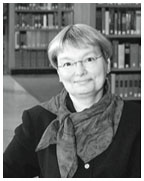Have an opinion about this issue of PAW? Please take a minute to click here and fill out our online questionnaire. It’s an easy way to let the editors know what you like and dislike, and how you think PAW might do better. (All responses will be kept anonymous.) |
March 23, 2005: President's Page
University Librarian Karin Trainer |
THE ALUMNI WEEKLY PROVIDES THESE PAGES TO THE PRESIDENT
In the Digital Age
I have invited University Librarian Karin Trainer to take you on a tour of Princeton’s evolving library system. As the Library builds on traditional strengths, it is also embracing the electronic tools and resources that are transforming the way we gather, organize, and disseminate information. — S.M.T.
Members of the Class of ’95 coming to campus for Reunions for the first time since graduation will be amazed at the changes in the Library. Library stacks that looked full in 1995 are now packed, as one million volumes have been added in the intervening years. Princeton’s librarians continue to acquire more than a mile’s worth of new books annually, and we continue to experience healthy growth in sound recordings, political archives, and other specialized research material.
Since 1995, whole new libraries have sprouted up, with the opening of the Mendel Music Library, the Stokes Library at the Woodrow Wilson School, the Engineering Library at the Friend Engineering Center, and the huge new storage library across Route 1. Comprehensive renovations have taken place in the Marquand Library of Art and Archaeology, the East Asian Library, and the Psychology Library, while Firestone now offers both a handsome reading room and the Cotsen Children’s Library on the first floor. By the time Reunions begin, the foundation will have been poured for the Peter B. Lewis Library focusing on the sciences. These new, remodeled, and expanded facilities give today’s students more comfortable and efficient spaces for research, study, and intellectual collaboration.
A less visible, but more profound, change in the library environment is the omnipresence of computers and the expansion of library services into the virtual space of the Internet. In 1995, students could use one of the Library’s early-generation “microcomputers” with black and white monitors capable of displaying text but not images; there were no Internet browsers. If a student carried her own computer into the Library, it was cause for considerable comment. Today the Library has a network of more than 1,000 powerful machines split between public and staff use. More than half of the students coming into the Library bring along a laptop, and we gladly lend these devices to those who do not have them.
Students in the Class of ’95 had access to a modest number of electronic databases and reference tools, but they were mostly in the form of CD-ROMs, which by their very means of manufacture and distribution could never be completely up to date. The Library maintained an elementary menu system pointing to some of its offerings, but there was no home page to guide library use. Finding out whether the Library had a particular book or CD-ROM was complicated because our online catalog was both primitive and incomplete.
By contrast, today’s students take advantage of more than 650 electronic databases in all fields; a list of recently acquired titles includes Black Short Fiction, Digital Dictionary of Buddhism, Armed Conflict Database, Annual Review of Nuclear and Particle Science, and the backfile of the Chicago Tribune. Students have access to many thousand digital books and 19,000 electronic journal subscriptions, all licensed by the Library and almost all Web-based. During the current academic year, library expenditures for digital content will have topped $3,000,000, not including money spent producing digital files in-house. As a matter of course, the Library now provides online versions of reserve reading assignments for more than 400 classes, and music listening assignments are delivered digitally as well. A high-end digital production studio in Firestone has begun to make copies of important items from the rare book and special collections units so that these, too, can be studied online.
To discover which titles the Library owns or licenses, which titles are on order, and which material has been checked out, students now consult a quick and reliable online catalog; the system incorporates clickable links, allowing students to move from the catalog records describing electronic resources to the resources themselves. Students can also connect to electronic resources by following links on the Library’s home page. For today’s students, the home page serves as the Library’s virtual front door, with connections to collections, services, and staff; in many cases, it also offers research guides prepared by Princeton’s talented subject librarians.
New services made possible by technology encourage students to do more sophisticated work. Paper writers hotly pursuing new research topics can use their computers to order the express delivery of books from six other major academic libraries. Students from all four divisions of the University are taking advantage of the Geographic Information Systems center established by the Library, and our laboratory for students conducting statistical analysis just had its busiest year ever.
Digital technology allows the Library to give students access to more
information than ever before, along with the most advanced tools to find
and organize it. Princeton’s librarians keep close tabs on the constantly
evolving information technology marketplace, testing new products with
educational potential. No one can predict all of the changes that will
occur in the next 10 years, particularly given the rate at which some
firms, including Google, are announcing new projects. While the details
of the long term are uncertain, it is safe to say that when members of
the Class of ’05 return to campus for their 10th reunion, they,
too, will be amazed at the changes in the Library. ![]()


